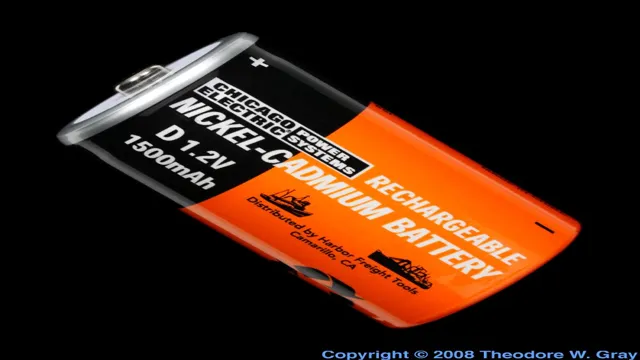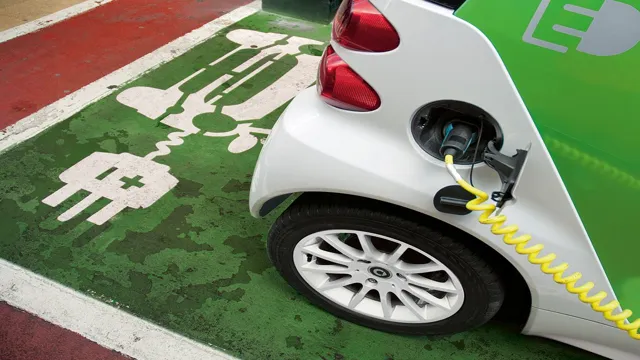Cadmium Batteries: Powerful and Sustainable Energy Solution for Electric Cars
Electric cars have been gaining popularity in recent years and with good reason. They are eco-friendly, cost-efficient, and quiet on the road. However, one question remains – what batteries should be used to power them? This is where cadmium batteries come in, offering their own benefits and drawbacks that are worth considering.
In this blog post, we will take a closer look at the advantages and disadvantages of using cadmium batteries in electric cars, so you can make an informed decision about which battery is best for you. So buckle up and let’s dive in!
Overview
Cadmium batteries have been used for a long time in various electronic devices due to their high energy density and long lifespan. However, when it comes to electric cars, they are not the most suitable option. This is because cadmium is a toxic metal that poses serious health and environmental risks if not handled or disposed of properly.
As a result, most electric car manufacturers avoid using cadmium batteries and instead opt for safer and more efficient alternatives like lithium-ion batteries. These batteries offer a similar energy density and lifespan, but without the same level of risk to human health and the environment. In conclusion, while cadmium batteries have their benefits, they are not the best choice for electric cars due to their potential harm to our health and the environment.
What are Cadmium Batteries?
Cadmium batteries are a type of rechargeable battery that is made using cadmium as one of its key components. These batteries have been around for quite some time and were commonly used in electronic devices like cameras, toys, and portable radios. However, due to the toxic nature of cadmium, cadmium batteries have largely been phased out and replaced by other types of batteries like lithium-ion batteries.
Cadmium batteries were known for their high energy density, which made them popular in devices that required a lot of power, but their toxicity and environmental impact eventually led to their decline. Nowadays, cadmium batteries are mostly used in niche applications like emergency backup power and military applications where their high energy density is still valued.

How are Cadmium Batteries Used in Electric Cars?
Cadmium Batteries in Electric Cars Electric cars are becoming increasingly popular and are widely acknowledged as a cleaner and more sustainable alternative to traditional gasoline-powered vehicles. The common use of electric cars has shown a shift towards energy storage solutions to make them more affordable. While lithium-ion batteries are prevalent in electric cars, cadmium batteries have also been used in some older models.
Cadmium batteries are known for their high energy density and are designed to provide long-lasting and reliable power. However, cadmium batteries also pose a significant environmental risk due to their toxic properties. For this reason, lithium-ion batteries are now the go-to choice for automakers.
Nonetheless, many older electric car models still rely on cadmium batteries, but these are slowly being phased out. The long-term goal for automakers is to transition to batteries that are both efficient and eco-friendly, ensuring a cleaner and more sustainable future for our planet.
Benefits of Using Cadmium Batteries for Electric Cars
Cadmium batteries may not be the most popular choice when it comes to electric cars, but they do have some benefits. For starters, they have a higher energy density compared to other types of batteries, meaning they can store more energy in a smaller space. This results in longer driving ranges and better acceleration.
Another benefit of cadmium batteries is their durability and long lifespan. These batteries can withstand a large number of charging and discharging cycles, which makes them a more cost-effective option in the long run. Additionally, cadmium batteries are more resistant to high temperatures, which can be a concern in some regions, and they are also not prone to thermal runaway, which is a safety hazard in other types of batteries.
However, it is important to note that cadmium is a toxic material and improper disposal can have harmful effects on the environment. Overall, while cadmium batteries may not be for everyone, they do have unique benefits that make them worth considering for electric car manufacturers.
Increased Energy Density
Cadmium batteries are becoming an increasingly popular choice for electric cars due to their increased energy density. This means that they can store more energy in a smaller space, making them lighter and more efficient than traditional lithium-ion batteries. Additionally, cadmium batteries have a longer lifespan and can withstand more charge and discharge cycles, improving their overall durability.
Another benefit of using cadmium batteries is their ability to operate at higher temperatures without degradation, reducing the need for complex cooling systems in hotter climates. Overall, the use of cadmium batteries in electric cars provides a multitude of benefits for both the environment and the driver, including increased efficiency, longer lifespan, and improved performance.
Longer Lifespan
If you’re in the market for an electric car, you may be considering the type of battery it uses. While lithium-ion is the most common type of battery for electric vehicles, cadmium batteries have some noteworthy benefits. One of the most significant advantages of using cadmium batteries is their longer lifespan compared to other types of batteries.
These batteries have a slower rate of degradation, meaning they can last up to 20 years or more with proper maintenance. This not only saves you money in the long run but also reduces the environmental impact of replacing batteries more frequently. Additionally, cadmium batteries can handle extreme temperatures better than other batteries, making them ideal for use in electric cars in areas with extreme weather conditions.
While there are some concerns about the toxicity of cadmium, proper disposal and recycling methods can mitigate this issue. Overall, if you’re looking for a reliable and long-lasting battery for your electric car, cadmium batteries are worth considering.
Improved Charging Capabilities
When it comes to electric cars, one of the biggest concerns is the range and charging time. However, using cadmium batteries can significantly improve charging capabilities and ultimately, the overall driving experience. Cadmium batteries have a unique ability to handle high current loads, which means they can be charged faster than other types of batteries.
This means less time spent waiting for the car to charge and more time on the road. Additionally, cadmium batteries have a longer lifespan, meaning they can handle repeated charging and discharging cycles without deteriorating as quickly as other batteries. This also means less frequent battery replacements and lower costs for the owner.
All in all, using cadmium batteries for electric cars is a smart choice that can greatly benefit the driver’s experience and wallet.
Better Low-Temperature Performance
Cadmium batteries are gaining popularity in the world of electric cars for a number of reasons, including their ability to perform well in low temperatures. Electric cars often struggle with battery performance in colder climates, as the frigid temperatures can cause the batteries to lose their charge quickly. However, cadmium batteries offer a solution to this problem.
These batteries are able to maintain their charge even in extremely cold weather, making them a highly desirable option for those who live in areas with harsh winters. Additionally, cadmium batteries are known for their durability and long lifespan, which means they can provide reliable performance for years to come. If you’re considering purchasing an electric car, it’s worth looking into models that use cadmium batteries to ensure better low-temperature performance.
Drawbacks of Using Cadmium Batteries for Electric Cars
Cadmium batteries were popularly used in electric cars in the past, but their drawbacks have now made them less appealing. One major problem with cadmium batteries is their toxicity, which makes them hazardous to dispose of. The disposal process can be harmful to the environment and even human health if not handled correctly.
Furthermore, cadmium batteries have a low energy density, which means they are heavy and bulky, making the electric cars heavier and less efficient. This translates to reduced driving range and the need for frequent recharging. Also, cadmium is a rare metal, which makes the batteries expensive and difficult to produce in large quantities.
Additionally, cadmium batteries have a shorter lifespan than other battery types, meaning they need frequent replacement, which adds to their already high cost. As a result of these drawbacks, manufacturers have shifted to using alternatives such as lithium-ion batteries, which have a higher energy density and are more environmentally friendly.
High Cost
One of the major drawbacks of using cadmium batteries for electric cars is their high cost. While they do offer a longer lifespan and higher energy density compared to other types of batteries, this comes at a price. The cost of cadmium batteries can be significantly higher than other options, making them a less popular choice among car manufacturers.
Additionally, the harvesting of cadmium itself can be a costly and environmentally damaging process. This makes it a less sustainable option for large-scale production. As a result, manufacturers are increasingly looking for more affordable and eco-friendly alternatives to cadmium batteries.
However, until such options become widely available, electric cars may continue to rely on these expensive batteries in order to deliver the power and performance that drivers demand.
Environmental Concerns
Electric cars are becoming increasingly popular due to their environmental benefits, but the use of cadmium batteries has become a cause for concern. While these batteries do provide high energy density, they also have several drawbacks. Cadmium is a highly toxic metal that can cause serious health problems, and its production results in significant environmental pollution.
Moreover, cadmium batteries have a shorter lifespan than other types of batteries and require careful disposal to prevent further environmental damage. Despite their advantages, the use of cadmium batteries in electric cars raises significant environmental concerns and highlights the need for more sustainable and eco-friendly alternatives. As we adopt new technologies, it’s crucial to consider their impact on the environment and take steps to minimize any negative effects.
Conclusion
In conclusion, Cadmium batteries for electric cars may have been an alternative in the past, but with the emergence of new, more sustainable battery technologies, relying on such a toxic and environmentally damaging element is no longer necessary. It’s time to move on from our love affair with Cadmium and embrace the new, cleaner and greener batteries of the future. Let’s not be stuck in the past, but rather, let’s power ahead with a brighter, more sustainable future.
After all, who wants a battery that’s more toxic than their ex?”
FAQs
What are cadmium batteries?
Cadmium batteries are rechargeable batteries that use cadmium as the primary electrode material.
Why are cadmium batteries not commonly used in electric cars?
Cadmium batteries have a lower energy density than lithium-ion batteries, which makes them less ideal for electric cars. Additionally, cadmium can be toxic and environmentally hazardous when not properly disposed of.
What are the advantages of using cadmium batteries in electric cars?
Cadmium batteries have a longer life cycle than nickel-cadmium batteries and are more resistant to overcharging and overheating.
Are cadmium batteries still being used in any electric cars today?
It is unlikely that any modern electric car uses cadmium batteries due to their lower energy density and environmental concerns.







